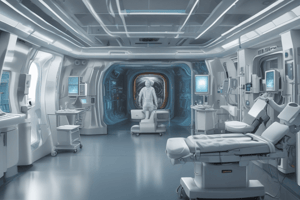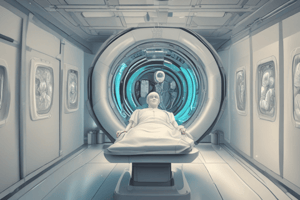Podcast
Questions and Answers
Kerry Greene-Donnelly has certifications through the ARRT in all of the following areas EXCEPT:
Kerry Greene-Donnelly has certifications through the ARRT in all of the following areas EXCEPT:
- Computed Tomography
- Magnetic Resonance Imaging (correct)
- Mammography
- Radiography
Which of the following best describes the spatial resolution of Computed Tomography (CT)?
Which of the following best describes the spatial resolution of Computed Tomography (CT)?
- Excellent, with the ability to distinguish between very similar tissues.
- Moderate, with the ability to image small objects that have high subject contrast. (correct)
- Very high, able to image a variety of very small high contrast objects.
- Low, limiting the visualization of small objects with high subject contrast.
Which of the following best describes temporal resolution of Computed Tomography (CT)?
Which of the following best describes temporal resolution of Computed Tomography (CT)?
- Moderate, depending on the reconstruction method used, ranging from 75ms to 300ms. (correct)
- Very high, capable of capturing extremely fast moving objects only.
- Excellent, able to freeze motion of the object being imaged at any speed.
- Very low, not able to freeze motion correctly.
In the context of CT imaging, what is the relationship between focal spot size and image detail?
In the context of CT imaging, what is the relationship between focal spot size and image detail?
The detector element size impacts detail in what way?
The detector element size impacts detail in what way?
Which of the following scan methods typically results in the lowest radiation dose, while also providing the fastest scan time?
Which of the following scan methods typically results in the lowest radiation dose, while also providing the fastest scan time?
What is another term for the number of projections acquired during a CT scan?
What is another term for the number of projections acquired during a CT scan?
Which of the following is inversely related to the level of detail in a CT image?
Which of the following is inversely related to the level of detail in a CT image?
What combination of parameters would result in the best spatial resolution?
What combination of parameters would result in the best spatial resolution?
Which of the following has the most impact on contrast resolution?
Which of the following has the most impact on contrast resolution?
Flashcards
Contrast Resolution
Contrast Resolution
The ability to distinguish between and image similar tissues. Measured by the smallest difference in tissue attenuation that can be detected.
Temporal Resolution
Temporal Resolution
The ability to freeze motion of the object being imaged. Measures the time it takes to acquire a single slice.
Spatial Resolution
Spatial Resolution
The ability to image small objects that have a large difference in density. Measured by the smallest detail that can be resolved.
Focal Spot Size
Focal Spot Size
Signup and view all the flashcards
Detector Size
Detector Size
Signup and view all the flashcards
Sampling Frequency
Sampling Frequency
Signup and view all the flashcards
High Frequency Kernels
High Frequency Kernels
Signup and view all the flashcards
Slice Thickness
Slice Thickness
Signup and view all the flashcards
Pitch
Pitch
Signup and view all the flashcards
Study Notes
CT Image Quality and Dose Considerations
- CT image quality and dose are dependent factors.
- Generally, increasing image quality increases dose.
- Considerations must be made to balance patient dose with required quality.
- Consultation with radiologists and medical physicists is crucial for optimal image quality at the lowest possible dose (ALARA).
CT Image Quality
- Spatial Resolution:
- Ability to image small objects with high subject contrast.
- CT has moderate spatial resolution (20 lp/cm).
- In-plane resolution measured by X/Y axis.
- Through-plane resolution measured by Z-axis.
- Factors affecting spatial resolution in-plane: Focal spot size, Detector size, Scanner geometry, Sampling frequency, Reconstruction algorithm, Field of View (FOV).
- Factors affecting through-plane resolution: Slice thickness, Pitch
- Contrast Resolution:
- Ability to distinguish between and image similar tissues.
- CT has excellent low contrast detectability (0.25-0.5% difference in tissue attenuation).
- Temporal Resolution:
- Ability to freeze the motion of the object being imaged.
- CT has moderate temporal resolution (~300ms for full segment reconstruction).
- Faster speeds possible with 4 segment reconstruction (75ms).
Focal Spot Size (FSS)
- Inversely related to detail
- Increased detail requires decreased FSS
- FSS is mA dependent and automatically selected.
- Flying Focal Spots (Siemens Somatom) allow slight focus changes, increasing data points, and sampling.
Detector Size/Spacing
- Inversely related to detail
- Increased detail requires decreased size or spacing between detector elements.
- Not a selection made by the technologist, dependent on CT scanner make and model.
Scanner Geometry
- Directly related to detail
- Increased detail requires increased scan geometry.
- Describes the arc or amount of tube movement.
- Several types: 360°, Two 180°, One 180°, One 400°.
Sampling Frequency
- Directly related to spatial resolution
- Increased sampling increases detail in an image.
- Number of projections is also known as the "sampling frequency".
- Accomplished by increasing the sampling rate or the speed at which detectors are read.
Reconstruction Algorithm
- Directly related to spatial resolution
- Detail increases as spatial frequency of a filter increases.
- High-frequency kernels (sharp, edge, bone or FC 50+).
Pixel/FOV/Matrix
- Pixel: Inversely related to detail, smaller is better.
- Matrix: Directly related to detail, bigger is better.
- Technologist does not directly control pixel or matrix.
- FOV: Inversely related to detail, smaller is better.
- Technologist controls FOV used for scanning/viewing
- Pixel = FOV / matrix
Slice Thickness
- Inversely related to spatial resolution
- Increased slice thickness decreases detail in image.
- Thick slices increase SSP and partial volume averaging.
Pitch
- Inversely related to spatial resolution
- Increases in pitch decrease image detail and increase partial volume averaging.
- Important in MSCT to use a pitch that provides non-overlapping spirals e.g. a pitch of 1.5 for a 4-slice is needed to avoid overlapping.
Contrast Resolution Factors
- Object size: Larger objects are easier to visualize.
- Object attenuation difference: Higher attenuation differences are easier to see.
- Noise: Variations in pixel values (mottled or grainy appearance).
- kVp: Indirectly related to noise, directly related to contrast resolution.
- mA(s): Inversely related to noise, directly related to contrast resolution; doubling mAs reduces noise by half.
- Pitch: increased pitch decreases contrast resolution.
- Slice thickness: increased slice thickness decreases contrast resolution.
Noise Factors
- mA (directly related to contrast resolution):
- kVp (inversely related to noise):
- Pixel size:
- Slice thickness:
- Detector efficiency:
- Interpolation scheme (filtering):
mAs
- Indirectly related to noise and directly related to contrast resolution.
- Increasing mAs decreases noise and increases ability to see slight differences in attenuation.
- Doubling mAs reduces noise by half.
- Controlled by the technologist.
kVp
- Indirectly related to noise and directly related to contrast resolution.
- Increasing kVp increases dose.
- Should not be primary method for reducing noise.
Pixel/Slice Thickness
- Indirect relationship to noise
- Decreasing pixel/slice size increases noise.
Temporal Resolution
- Decreasing subject motion best resolved by increasing temporal resolution (faster scanning).
- Decreased rotation times are common (1 - 1/2 sec).
- Cardiac imaging needs excellent temporal resolution for small cardiac vessels.
Segment Reconstruction and Gating
- Cardiac studies usually use pitch of 0.2 and result in 5 images of the same anatomy.
- Using segments from multiple rotations decreases overall time and improves reconstruction time to 75ms from 300ms.
- Gating tags each image, allowing the computer to select images from a specific point in the cardiac motion.
Image Quality and Dose
- Maintaining optimal image quality and reducing patient dose is key concern of CT imaging.
- Radiologist/Medical Physicist consultation is critical.
CT Dose
- CTDI is measured using an acrylic phantom and an ionization chamber.
- CTDI has several types (e.g., CTDI 100, CTDI w, CTDI vol). -CTDI 100 accounts for a slice and scatter over 100mm
- CTDI w accounts for increased skin exposure and decreased center exposure. -CTDI vol accounts for pitch in spiral imaging and accounts for patient exposure dose.
Scanner Provided Values
- Scanner provides estimated CTDI vol before the scan and at termination of scan.
- These are estimates, not patient dose.
- DLP (Dose-Length Product) is calculated by multiplying CTDI vol with scan length.
- CTDI is useful in comparing scanners/protocols.
- CTDI reports output but tissue volume is key issue to consider.
- Small patients receive more dose with the same CTDI vol.
ACR CTDI Guidelines
- Adult (head: 75 mGy, abdomen: 25 mGy).
- Pediatric (abdomen: 20 mGy).
Dose Factors
- Filtration decreases dose by filtering low-energy rays. 2.5mm AL is common. Most units has 6-9mm AL which decreases beam hardening artifacts.
- Technologists do not have control of the beam shaping filter.
Detector Configuration
- Thin slices increase dose because more slices are needed to cover a given area.
- Thick slices decrease dose because fewer slices needed.
- Larger number of slices per rotation is more dose efficient. e.g. 16, 1.25 mm slices, are more dose efficient than 4. 1.25 mm slices.
Pitch or Increment
- Pitch is the ratio of table feed to beam width.
- Equal pitch indicates no gap or overlap in radiation.
- Increment is used in axial imaging, ration of slice thickness to table feed. Descriptions of contiguous, overlapping or gaps.
- Overlap increases dose, gaps decrease dose.
Dose Modulation
- Similar to Automatic Exposure Control (AEC) in radiography.
- mA or dose modulation software varies exposure.
- Patient positioning, no metal in FOV, and proper shielding required for proper dose management
- Off-center errors in X or Y axis increase dose.
- mA is set at minimum and maximum levels and software varies the mAs for the anatomy and view.
Automatic Tube Current Modulation
- Different manufacturers use many names for this technique.
- mAs modulated (X/Y, Angular, z-axis)
- Automatically adjusts for image noise and keeps quality while saving on dose.
Dose vs. Noise
- Demonstration of difference between constant and modulated tube current.
References
- Various texts on radiologic sciences, computed tomography and AAPM materials are referenced.
Studying That Suits You
Use AI to generate personalized quizzes and flashcards to suit your learning preferences.




